|
|
Recife lighthouse
«Recife
«Entertainment in Recife and Pernambuco
The Farol do Recife (Recife Lighthouse) guides boats and ships approaching the Port of Recife.
History
Translated and adapted from this page, by the Fundação Joaquim Nabuco, the cultural foundation of the State of Pernambuco.
In the 16h century, Pernambuco was the largest producer of sugar cane in the World; the production was exported through the Port of Recife.
In 1590, preoccupied with the threatens of invasions by foreigners (indeed, the Dutch would capture Recife and Olinda in 1630 - read History of Recife and Olinda), the Portuguese King ordered the construction of a Fort, to protect the access to the port. The Fort was constructed on the northern end of the natural line of reefs which exist all along the coast of Pernambuco (see Localization, below); besides being an strategic position, there was the advantage that the reefs would provide a strong foundation to the fort. Historic books register two names for the fort: Castelo do Mar (Sea Castle) and Forte Laje do Picão (picão is the name of a medicinal Brazilian plant).
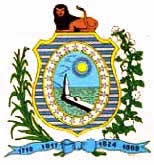 When the Dutch dominated Recife, between 1630 and 1654, they used the Fort to send orientation signs to the ships approaching the coast. After the Dutch were expelled, the Portuguese continued using the Fort to send signs.
When the Dutch dominated Recife, between 1630 and 1654, they used the Fort to send orientation signs to the ships approaching the coast. After the Dutch were expelled, the Portuguese continued using the Fort to send signs.
In 1817, the Fort was wrecked. The Portuguese King, D. João VI, decided to rebuild the fort and turn it into a lighthouse. The official date of inauguration of the Farol do Picão is February 1st 1822.
In 1931, the lighthouse was shut down. In 1932, it was turned on again, this time with an automatic lantern AGA of 500 mm. In 1938, the lighthouse was moved to the building of the Capitania dos Portos.
In 1945, the lighthouse was brought back to the Fort, and has stayed there ever since; until today, it emits flashes to orientate ships.
The lighthouse is a Historic landmark of Pernambuco, being present in the Coat of Arms of the State.
Localization
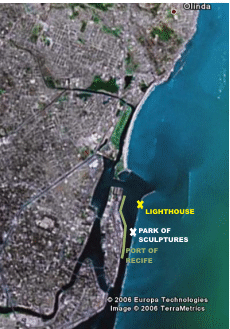 The Recife lighthouse was constructed near the northern end of the reef line which follows along the coast (see map).
The Recife lighthouse was constructed near the northern end of the reef line which follows along the coast (see map).
It is easy to see that the lighthouse is on an strategic position for guidance of ships and defense of the port.
It is interesting to notice that the straight line of reefs which follows southwards from the lighthouse is natural (not built by man). This perfect alignment impressed Charles Darwin, who had a travel to Recife in the 19th century and made appointments about the reefs (to read more, click here and see reference to pages 527 and 528 of Darwin's writings).
Besides the lighthouse, other buildings were constructed on the reefs. In the 19th century, a House of Baths was in operation (today, it's a restaurant). The Parque das Esculturas (Park of Sculptures), which today is one of the major touristic sites in Recife, was opened in 2000.
Today, it is possible to visit the lighthouse and the wreckages of the old fort. Rustic boats take tourists from the Port of Recife to the Park of Sculptures; it is possible to walk from the Park to the lighthouse. It is also possible to drive a car all along the reefs, as far as the Park, then walk to the lighthouse.
Photos
Below, some photos of the Farol.
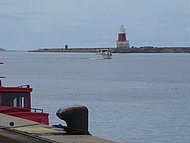
Recife lighthouse, seen from Port of Recife. Click here for an enlarged picture.
|
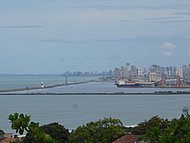
Viewing from Olinda. The photo shows the lighthouse, the sculptures, the port and the buildings of Recife.
|
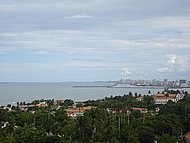
Another viewing from Olinda, showing how far the breakwater goes.
|
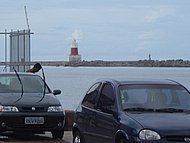
A picture from the point where boats leave to the Park of Sculptures.
|
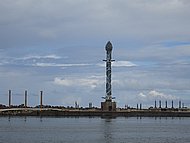
The Park of Sculptures.
|
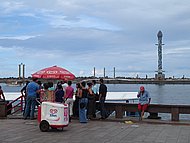
Tourists boarding the boat to go to the Park.
|
| |
 When the Dutch dominated
When the Dutch dominated  The Recife lighthouse was constructed near the northern end of the reef line which follows along the coast (see map).
The Recife lighthouse was constructed near the northern end of the reef line which follows along the coast (see map).




